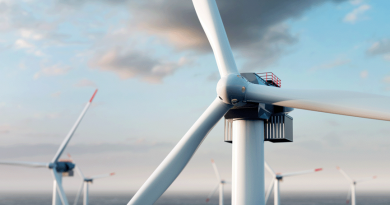Unlocking the power of ideas
Christine Lagarde is President of the European Central Bank
Not too far from here, tucked away in the Sterling Memorial Library in the heart of Yale’s campus, lie the papers of America’s first diplomat, Benjamin Franklin. Franklin was many things – ambassador to France, scientist, inventor, writer and publisher, to name a few – but above all, he was a man of ideas. As a young man Franklin understood the power of ideas.
“All our ideas are first admitted by the senses and imprinted on the brain, increasing in number by observation and experience,” he wrote. “There they become the subjects of the soul’s action.”1
By inspiring action, ideas can help us grow. This might be personal growth – a student’s learning, say, allowing them to make the right decisions throughout their future career. But it holds at the societal level too: ideas help push our economies forward.
In recent decades, we had few barriers globally to the flow of ideas. Advanced economies shared their technologies with emerging ones, and emerging economies shared their cheaper input costs with us – the process we knew as ‘globalisation’. But in recent years, the global economic order as we know it has been changing.
We now see that previously emerging economies are taking leadership in some advanced technologies. And we are seeing globalisation go into reverse, threatening access to the resources on which advanced technologies depend. So, how do we all prosper in this new world? I will argue that the key ingredient for our prosperity remains the same as ever: generating and sharing new ideas.
But history tells us that ideas can only drive growth if we first create the right conditions that allow them to reach their full potential – and if we are committed to breaking the bottlenecks that stand in their way. This is the challenge we all face today to thrive in this new world. And today, I will focus on what this challenge means for our economies and, in particular, for Europe.
The power of ideas across history
The history of human progress has been defined by technological breakthroughs generated by ideas. But ideas do not immediately translate into economic prosperity. Take Johannes Gutenberg’s printing press – an ingenious device that combined metal prisms for moulding letters with an oil-based ink and techniques found in wine production2.
By reducing the cost and increasing the speed at which books were produced, the printing press unleashed a communications technology that would revolutionise our world. In fact, an original Gutenberg bible is on display in the beautiful setting of the Beinecke Rare Book and Manuscript Library in Yale. But the printing press arrived at a time when literacy rates were still exceptionally low – around 9% in Gutenberg’s native Germany3.
Its ultimate benefits depended on rising literacy rates in the centuries that followed, with cheaper and more plentiful books also lowering the costs of learning. Countries that were quicker to embrace literacy reaped the gains in higher rates of economic growth and GDP per capita – a correlation that persists to this day4. In more recent centuries, we can identify three conditions that need to be in place for ideas to reach their full potential: translation, diffusion and ambition.
Translation means the ability to translate ideas into socially usable projects. And history has shown us that this ability depends on having the right economic ecosystems in key areas like finance and the supply of inputs. For example, until the turn of the 17th century, the ability to fund new ideas was severely limited by underdeveloped financial markets. One factor that helped change the game was the emergence of the modern joint-stock, limited-liability company around this time5.
Suddenly, large pools of capital could be raised to fund bold proposals, such as expanding global shipping routes from east to west, which facilitated supplies of inputs. Countries that embraced joint-stock companies tended to experience faster growth6.
If the right economic ecosystem infrastructures can facilitate ideas, the reverse is also true. The pioneering rollout of railroads across the US continent proved revolutionary in spurring the development of the country’s capital markets7.
But for ideas to be truly impactful at the macro level, there also needs to be diffusion. Technologies need to spread through an economy and become widely used. History suggests that a key factor in the diffusion of ideas is scale: that is, operating in a large, integrated market. Scale encourages firms to adopt new technologies, so that by expanding their production they can achieve lower unit costs.
The clearest example of the impact of scale is in the United States. While its constitution brought together thirteen disparate colonies, the country’s economic trajectory would ultimately depend on how that constitution – in particular its Commerce Clause – was interpreted.
A pivotal moment occurred in 1824, when the Supreme Court’s decision in Gibbons v. Ogden asserted the right of Congress to regulate interstate commerce and, in effect, to override state-granted monopolies that risked fragmenting the US market. This decision helped establish a truly nationwide economy and allowed the ideas of US entrepreneurs to spread and flourish. By several estimates, US GDP per capita at least doubled between 1800-20 and 1820-408.
In many of these cases, however, change did not happen by itself. It happened because of the ambition of entrepreneurs, economists, jurists or policymakers, their courage in overcoming hurdles to progress, and their ability to inspire others to follow their vision. But the nature of this ambition always evolved with the times.
In the 1800s, remote states scattered across the United States needed visionary entrepreneurs like Cornelius Vanderbilt, whose railways helped unify the country’s economy. But as railroad tycoons established monopolies that undermined the public good, it took the ambition of policymakers like Theodore Roosevelt to break them up and foster competition.
What truly unlocks growth is when these three forces combine: when ideas translate into innovations, innovations diffuse into productivity growth, and our societies have the necessary ambition to remove any barriers that are in the way.
The power of ideas today
This brings me to the present day. As our economies grow, the relative importance of the different forces that drive growth changes9. For emerging economies that are far away from the technological frontier, deploying first their labour and later capital can help them to catch up.
But once economies mature and become advanced, productivity increases are mostly what propels us forward. And productivity is above all about ideas.
Most advanced economies, however, have seen productivity decelerate for some time. This slowdown led to a debate in the 2010s between techno-pessimists, who believed that most groundbreaking ideas were behind us, and techno-optimists, who believed that we were on the cusp of a new technological revolution.
Developments in recent years suggest that the case for optimism was stronger. Just as in Gutenberg’s time, new revolutionary technologies like artificial intelligence (AI) and robotics are on the verge of transforming our societies. One study finds that generative AI alone has the potential to add up to almost USD 4.5 trillion annually to the global economy, roughly 4% of global GDP10.
The good news for global productivity growth is that we see these new ideas flourishing across major economies, a direct legacy from the common ties that were crafted during the era of globalisation. And Europe, in contrast to what some may believe, is actually well placed to benefit from these ideas.
The European Union accounts for around one-fifth of the world’s most-cited publications, patents, and research – despite making up less than 7% of the global population11 – and this innovative activity includes key sectors such as AI and machine learning. According to one study, Europe draws in more AI talent than the United States, with over 120,000 active AI roles, and last year, Europe accounted for one-third of total early-stage capital invested in AI and machine learning across the two economies12.
Our region also has many innovative companies in other high-tech sectors. Europe’s manufacturing firms often operate at the global frontier, be it in producing photolithography machines for advanced chips or industrial robotics. In fact, Europe’s share of the market for such robots is double that of China and more than thirtyfold that of the United States13.
And many of Europe’s most successful companies are not even listed. Of the 2,700 ‘hidden champions’ worldwide – that is, small and medium-sized enterprises that are global leaders in their niche markets – more than half are found in Germany, Austria and Switzerland14.
But as globalisation recedes and technological change accelerates, all economies are facing bottlenecks in transforming these ideas into sustained productivity growth. And these bottlenecks are in the same three areas that have been critical to unlocking the potential of ideas throughout history: translation, diffusion and ambition. So, the question we face is: how can we break these bottlenecks?
What truly unlocks growth is when these three forces combine: when ideas translate into innovations, innovations diffuse into productivity growth, and our societies have the necessary ambition to remove any barriers that are in the way
Breaking the bottlenecks
Translation
Let me start with the first bottleneck, translation. To translate new ideas into marketable projects, we need economic ecosystems that are suited to the specific requirements of today’s technologies. We need financial systems that allow us to invest massively in innovative firms.
Sectors like AI, for example, need a lot of cash upfront to build up computing power and server capacity. According to industry leaders, the cost of training AI models is set to jump tenfold in the space of a year, and could soon rise to between USD 5 and 10 billion15.
And we need secure access to a wide range of natural resources. The International Energy Agency estimates that training a single AI model uses more electricity than 100 US households consume in an entire year16. And as we electrify our transport systems and invest in renewable energy technologies, global demand for rare earth elements may increase three to sevenfold between now and 204017.
So, all our economies need to be proactive in ensuring that we have these ecosystems in place. But in Europe we face two specific challenges. First, we have a large financial sector, backed by high rates of saving from European households. But intermediation mainly takes place through bank lending rather than capital markets, which issue bonds and equities.
Bank lending works well for established companies that are relatively low risk and have generous collateral, such as our traditional manufacturing leaders. But it works less well for young, high-risk companies that typically drive radical innovation.
Innovative companies need access to ample risk capital, which requires a large venture capital sector that can back them until they go public. But the availability of risk capital is around ten times lower in Europe than in the United States18, meaning that even firms that find backing at the early stage have less support when they enter the growth stage. The average venture capital-backed company in the EU receives about five times less backing than its US peers over its life cycle19.
This gap often means that European entrepreneurs have to go overseas to get the financing they need – and sometimes their ideas go with them. And it is a key reason why, last year, Europe invested just USD 1.7 billion in generative AI compared with USD 23 billion of US venture capital and private equity20.
Second, we are not endowed with significant natural resources in Europe, meaning that we depend heavily on imports21. And this dependency leaves us vulnerable in a less globalised world and a changing geopolitical landscape.
The brutal Russian invasion of Ukraine, which led to an almost complete shut-off of gas supplies to Europe, shows what is at stake. Even though we have successfully replaced Russia as a supplier, that process has left our firms at a notable cost disadvantage.
Before the pandemic, electricity costs for European firms were 1.7 times higher than those in the United States and 1.2 times as high as China. Now, that gap is 2.5 and 2.3 times respectively. In both cases, however, Europe is creating solutions in response to these constraints. As the former French President, Valéry Giscard d’Estaing, is reputed to have said, “We may not have oil, but we have ideas.”
Where we can, we are acting to build the ecosystems we need internally. Europe’s leaders have agreed to push forward with developing Europe’s capital markets union, with a strong focus on improving the conditions for the financing options of European scale-ups22. We are also frontloading investment in renewables, which will ultimately make us more energy independent, although this process will take time and we will need to be realistic.
In the interim, we may need to depend even more on countries that have the necessary resources. For example, 80% of the global supply for rare earth metals currently comes from just three countries23. But we are also working together with our friends and allies who face similar bottlenecks, like the United States, to make our supply more diversified. For example, the EU intends to establish a Critical Raw Materials Club, inviting partners with similar geopolitical and economic security concerns to join in the pooling of investments24.
Diffusion
But once ideas are commercialised, they need to be diffused. Remember that what drives long-term growth is not only innovation by superstar firms, but also that innovations spread widely to less productive ones. Historically, one of the strongest drivers of technology diffusion has been free trade, especially between our two economies. For example, analysis points to a lag of three to four years between innovations in US industry and those in European industry25.
But research suggests that diffusion has slowed across advanced economies in recent decades26 – a trend that may partially reflect the nature of the digital economy itself, which tends to create ‘winner-takes-the-most’ markets27. And in Europe’s specific case, slow diffusion also reflects the fact that, unlike the United States, we have not yet fully unlocked our innate scale as a continental-sized economy.
We have developed a business model in Europe that is unusually reliant – for a large economy, at least – on selling to other large economies, including capital goods that enable them to exploit their own scale. More than a third of our manufacturing GDP is absorbed outside the EU, compared with around a quarter for China and just a fifth for the United States28.
But we have not made full use of our own scale to encourage our companies to adopt more technology. We are home to over 445 million consumers and 23 million firms29 and yet our internal market remains fragmented, especially for services30. Intra-EU trade in services accounts for only about 15% of GDP compared with over 50% for goods31.
This untapped potential is costing us dearly in terms of foregone growth and productivity gains. Remaining trade frictions in the EU mean that we are leaving around 10% of potential EU GDP on the table, according to one estimate32.
And it is also affecting our competitiveness. We now see that other major economies are using their combination of technology and scale to push ahead faster in key sectors. China may now be leading in 37 of 44 critical technologies including electric batteries, hypersonics and advanced high-frequency communications such as 5G and 6G33.
But Europe is also acting on this front to lift its constraints. Europe’s leaders welcomed a major new report on the Single Market, calling for removing the remaining barriers in the crossborder provision of services as well as a ‘policy shift’ to reflect the new geopolitical and competitive environment34.
And here again, Europe and the United States have shared interests in working together, especially in ensuring a level playing field between countries that play by the rules, while acting robustly in instances where rules are being broken to create an unfair advantage35.
In other words, we should not become engaged in a subsidy race between our economies, which creates a zero-sum game. We should instead ensure that we use our collective weight in international trade to discourage others from anti-competitive practices, while increasing the free flow of ideas amongst ourselves – a positive-sum game.
Ambition
Will we be able to achieve all this? Ultimately, it is a question of ambition – and that is the final bottleneck we will have to break. In recent years, leadership has often been reactive in nature. This has been somewhat understandable in an era of ‘permacrisis’ – in which one shock, like the pandemic, is quickly followed by another, such as the outbreak of war.
But reactive leadership is no longer enough. Crises are becoming ever more global, requiring unprecedented levels of coordination across several sectors of society. And at the same time, the world is moving in directions that make such cooperation more difficult.
That is why we need proactive leadership – where we define the flow of events instead of simply responding to them. And for this we need to be far more ambitious.
The history of Europe gives us many examples of how effective such leadership can be. In the 1950s, an era marked by supply shortages and rationing, Europe started building common supply chains and pooling the production of inputs such as coal and steel.
In the mid-1980s, when Europe had exhausted the potential of what was then its common market, it forged ahead by creating the Single Market and reinvigorating growth. And in the 1990s, when exchange rate volatility threatened the stability of our currencies, we pushed forward with our monetary union to anchor our Single Market.
In doing so, we achieved what many had once thought impossible, and progressively united a continent that had been torn apart by two world wars.
When I look across advanced economies today, I am confident that our leaders understand what is required of them. Both the CHIPS Act and Inflation Reduction Act in the United States are accelerating the take-up of new technology. And I have listed many initiatives in Europe that are in the works, while there are many more that I have not touched upon.
But focusing on Europe in particular, what gives me hope is that, unlike after the great financial crisis, both leaders and citizens are aligned on what needs to be done. We realise that we can no longer afford to see ourselves as a loose club of independent economies.
That perspective is outdated in a world that is fragmenting into geopolitical blocs centred around the largest economies. And we know that we need to start seeing ourselves as a single, large economy with predominantly shared interests. This change in perspective also calls for joining forces in more areas.
We face increasing demands on spending from ageing populations, the climate transition and a changing security environment that we will only be able to meet together. And if we do not, we will face some difficult choices between sustaining our social model, delivering on our climate ambitions and playing a leading role in global affairs.
By acting as a Union to raise our productivity growth, and by pooling our resources in areas where we have a tight convergence of priorities – like defence and the green transition – we can both deliver the outcomes we want and be efficient in our spending so that we do not have to make sacrifices elsewhere.
And while this approach may require breaking some long-established taboos, we say in French that “nécessité fait loi” – or necessity knows no law. Our citizens understand this reality, even in a context where populism is on the rise. We see in poll after poll that Europeans believe that acting together is the best route to prosperity and security.
Over two-thirds of EU citizens feel that the EU is a place of stability in a troubled word36, more than three-quarters are in favour of a common defence and security policy37, and eight out of ten agree that the EU needs to invest massively in areas like renewable energy38. And in the euro area, support for our single currency remains close to record levels39.
So I am confident that the ambition of our policymakers and the will of our people are aligned, and that we will break the bottlenecks that are preventing us from reaching our potential.
Conclusion
The global economy finds itself at a turning point, with old realities being replaced by new uncertainties. But amid all this change, some things remain resolutely the same. It is by generating new ideas, and creating the conditions in which they can spread and flourish through our economy, that we can drive future growth.
To create those conditions, Europe needs to break key bottlenecks in translation, diffusion and ambition. This will not be easy. But for too long we have simply talked about these problems instead of solving them through concrete actions. As Franklin once put it, “Well done is better than well said.”40
In the end, we have a simple choice to make: either we break these bottlenecks, or we let these bottlenecks break us. Given the sense of urgency, the support for action and the consensus on what Europe needs to do, I know which side I stand on. And I am confident we can succeed.
Endnotes
1. Franklin, B (1725), “A Dissertation on Liberty and Necessity, Pleasure and Pain”.
2. Manguel, A (1997), A history of reading.
3. “Literacy rate, 1475 to 2022” on Our world in data.
4. “Literacy rate vs. GDP per capita, 2022”, on Our world in data.
5. Ferguson, N (2008), The ascent of money: a financial history of the world.
6. By extension, the embrace of the joint-stock company arguably facilitated what some economic historians have dubbed the “great divergence” between a dynamic Europe and the rest of the world. A short overview of the great divergence – a concept that has attracted debate among economic historians – is offered in Allen, RC (2011), The great divergence, Oxford University Press.
7. As recently discussed in Lagarde, C (2023), “A Kantian shift for the capital markets union”, speech at the European Banking Congress, 17 November.
8. Valued in 1840 prices. See Weiss, TJ (1992), “U.S. Labor Force Estimates and Economic Growth, 1800-1860”, in RE Gallman and JJ Wallis (eds.), American Economic Growth and Standards of Living before the Civil War, Chicago University Press.
9. As put forward in the Solow Growth Model.
10. McKinsey Digital (2023), “The economic potential of generative AI: The next productivity frontier”, 14 June.
11. European Commission (2023), “Long-term competitiveness of the EU: looking beyond 2030”, 16 March.
12. Atomico (2023), “State of European Tech 23”.
13. European Commission (2023), “AI Watch – Evolution of the EU market share of Robotics”, JRC Technical Reports, 14 April.
14. Simon, H (2012), Hidden Champions – Aufbruch nach Globalia: Die Erfolgsstrategien unbekannter Weltmarktführer, Campus Verlag, Frankfurt/New York.
15. The New York Times (2024), “Transcript: Ezra Klein Interviews Dario Amodei”, 12 April.
16. IEA (2023), “Why AI and energy are the new power couple”, 2 November.
17. IEA (2021), “The Role of Critical Minerals in Clean Energy Transitions”, May.
18. Risk capital as a percentage of GDP. See ECB (2023), “The EU’s Open Strategic Autonomy from a central banking perspective – challenges to the monetary policy landscape from a changing geopolitical environment”, Occasional Paper Series, No 311, Frankfurt am Main, March.
19. European Investment Fund (2023), Scale-up financing gap, 12 September.
20. McKinsey Global Institute (2024), “Accelerating Europe: Competitiveness for a new era”, 16 January.
21. For instance, the euro area imports around two-thirds of its energy, compared with just over one-fifth for the United States.
22. European Council conclusions, 17-18 April 2024.
23. China, South Africa and the Democratic Republic of Congo. See European Commission (2020), “Study on the EU’s list of critical raw materials – Final report”.
24. Council of the European Union, “An EU critical raw materials act for the future of EU supply chains”.
25. International Monetary Fund (2015), “World Economic Outlook: Uneven Growth: Short-and Long Term Factors”, April.
26. Calvino, F and Criscuolo, C (2022), “Gone digital: Technology diffusion in the digital era”, Brookings Institution, 20 January.
27. Schnabel, I (2024), “From laggard to leader? Closing the euro area’s technology gap”, inaugural lecture of the EMU Lab, 16 February.
28. ECB (2023), op. cit.
29. Council of the European Union, “EU single market”.
30. Around 70%.
31. Schnabel, I. (2024), “From laggard to leader? Closing the euro area’s technology gap”, inaugural lecture of the EMU Lab at the European University Institute, 16 February.
32. in ‘t Veld, J (2019), “Quantifying the Economic Effects of the Single Market in a Structural Macromodel”, Discussion Paper Series, No. 94, European Commission, February.
33. Australian Strategic Policy Institute (2023), “ASPI’s Critical Technology Tracker – The global race for future power”, 22 September.
34. European Council conclusions, op. cit.
35. European Commission (2023), “Commission launches investigation on subsidised electric cars from China”, 4 October.
36. Eurobarometer (2023), “Standard Eurobarometer 100 – Autumn 2023”.
37. Eurobarometer (2023), “Standard Eurobarometer 99 – Spring 2023”.
38. Eurobarometer (2023), “Standard Eurobarometer 100 – Autumn 2023”.
39. Eurobarometer (2023), “The euro area”.
40. Franklin, B (1737), “Poor Richard’s Almanack”.
This article is based on a speech by delivered at Yale University in New Haven, USA, 22 April 2024.




